Direct current electric circuits and their characteristics
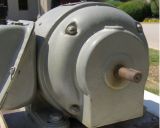 Properties DC motors are mainly determined by the way the excitation coil is turned on. Depending on this, electric motors are distinguished:
Properties DC motors are mainly determined by the way the excitation coil is turned on. Depending on this, electric motors are distinguished:
1. independently excited: the excitation coil is powered by an external DC source (exciter or rectifier),
2. parallel excitation: the field winding is connected in parallel with the armature winding,
3. series excitation: the excitation winding is connected in series with the armature winding,
4. with mixed excitation: there are two field windings, one connected in parallel with the armature winding and the other in series with it.
All these electric motors have the same device and differ only in the construction of the excitation coil. The excitation windings of these electric motors are performed in the same way as in respective generators.
Independently excited DC electric motor
In this electric motor (Fig.1, a) the armature winding is connected to the main direct current source (direct current network, generator or rectifier) with a voltage U, and the excitation winding is connected to an auxiliary source with a voltage UB. A regulating rheostat Rp is included in the circuit of the excitation coil, and a starting rheostat Rn is included in the circuit of the armature coil.
The regulating rheostat is used to regulate the armature speed of the motor and the starting rheostat is used to limit the current in the armature winding when starting. A characteristic feature of the electric motor is that its excitation current Iv does not depend on the current Ii in the armature winding (load current). Therefore, neglecting the demagnetizing effect of the armature reaction, we can approximately assume that the motor flux F is independent of the load. The dependences of the electromagnetic moment M and the speed n on the current I will be linear (Fig. 2, a). Therefore, the mechanical characteristics of the engine will also be linear — the dependence n (M) (Fig. 2, b).
In the absence of a rheostat with resistance Rn in the armature circuit, the speed and mechanical characteristics will be rigid, that is, with a small angle of inclination to the horizontal axis, since the voltage drop IяΣRя in the windings of the machine included in the armature circuit at rated load is only 3-5% of Unom. These characteristics (straight lines 1 in Fig. 2, a and b) are called natural. When a rheostat with resistance Rn is included in the armature circuit, the angle of inclination of these characteristics increases, as a result of which a family of rheostat characteristics 2, 3 and 4 can be obtained, corresponding to different values of Rn1 , Rn2 and Rn3 .
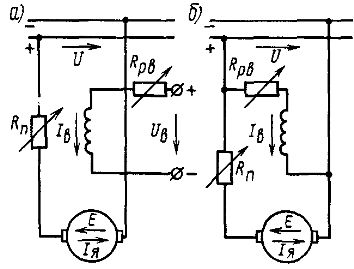
Rice. 1.Schematic diagrams of DC motors with independent (a) and parallel (b) excitation
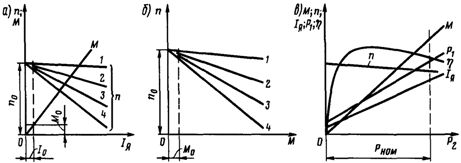
Rice. 2. Characteristics of electric motors direct current with independent and parallel excitation: a — speed and torque, b — mechanical, c — working The greater the resistance Rn, the greater the angle of inclination of the characteristic of the rheostat, that is, it is softer.
The regulating rheostat Rpv allows you to change the motor excitation current Iv and its magnetic flux F. In this case, the rotation frequency n will also change.
No switches and fuses are installed in the circuit of the excitation coil, because when this circuit is interrupted, the magnetic flux of the electric motor decreases sharply (only the flux of residual magnetism remains in it) and an emergency mode occurs. If the electric motor is running at idle speed or light load on the shaft, then the speed increases sharply (the motor moves). In this case, the current in the armature winding Iya increases significantly and a comprehensive fire may occur. To avoid this, the protection must disconnect the electric motor from the power source.
The sharp increase in rotation speed when the circuit of the excitation coil is interrupted is explained by the fact that in this case the magnetic flux Ф (up to the value of the Fost flux from the residual magnetism) and e. etc. v. E and the current Iya increases. And since the applied voltage U remains unchanged, the rotational frequency n will increase to e. etc. c. E will not reach a value approximately equal to U (which is necessary for the equilibrium state of the armature circuit, where E = U — IяΣRя.
When the shaft load is close to the rated one, the electric motor will stop in the event of a break in the excitation circuit, because the electromagnetic moment that the motor can develop with a significant reduction in magnetic flux decreases and becomes less than the torque of the load of shaft. In this case, the current Iya also increases sharply and the machine must be disconnected from the power source.
It should be noted that the rotation speed n0 corresponds to an ideal idle speed when the motor does not consume electrical energy from the network and its electromagnetic moment is zero. In real conditions, in idle mode, the engine consumes from the network the idle current I0, which is necessary to compensate for internal power losses, and develops a certain torque M0, necessary to overcome the frictional forces in the machine. Therefore, in reality the idle speed is less than n0.
The dependence of the rotational speed n and the electromagnetic moment M on the power P2 (Fig. 2, c) from the motor shaft, as follows from the considered relations, is linear. The dependences of the armature winding current Iya and the power P1 on P2 are also practically linear. Current I and power P1 at P2 = 0 represent the idle current I0 and power P0 consumed at idle. The efficiency curve is characteristic of all electric machines.
Electric motor direct current parallel excitation
In this electric motor (see Fig. 1, b) the excitation windings and the armatures are fed from the same source of electrical energy with a voltage U. A regulating rheostat Rpv is included in the circuit of the excitation winding and a starting rheostat Rp is included in the winding circuit on the anchor.
In the electric motor under consideration, there is essentially a separate supply of the armature and excitation winding circuits, as a result of which the excitation current Iv does not depend on the armature winding current Iv. Therefore, the parallel excitation motor will have the same characteristics as the independent excitation motor. However, a parallel excitation motor will only operate normally when powered by a constant voltage DC source.
When the electric motor is powered by a source with a different voltage (generator or controlled rectifier), a decrease in the supply voltage U causes a corresponding decrease in the excitation current Ic and the magnetic flux Ф, which leads to an increase in the armature winding current Iya. This limits the possibility of adjusting the armature speed by changing the supply voltage U. Therefore, electric motors designed to be powered by a generator or controlled rectifier must have independent excitation.
Electric motor direct current series excitation
To limit the starting current, the starting rheostat Rp (Fig. 3, a) is included in the circuit of the armature winding (Fig. 3, a) and to regulate the speed of rotation in parallel with the excitation winding by adjusting the rheostat Rpv can be included.
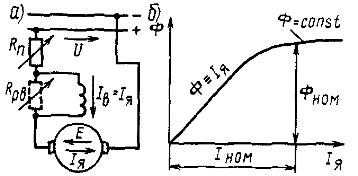
Rice. 3. Schematic diagram of the DC motor with series excitation (a) and the dependence of its magnetic flux Ф on the current I in the armature winding (b)

Rice. 4. Characteristics of the DC motor with sequential excitation: a — high speed and torque, b — mechanical, c — workers.
A characteristic feature of this electric motor is that its excitation current Iv is equal or proportional (when the rheostat Rpv is turned on) to the current of the armature winding Iya, therefore the magnetic flux F depends on the motor load (Fig. 3, b) .
When the armature winding current Iya is less than (0.8-0.9) of the rated current Inom, the magnetic system of the machine is not saturated and it can be assumed that the magnetic flux Ф changes in direct proportion to the current Iia. Therefore, the speed characteristic of the electric motor will be soft — as the current I increases, the rotational speed n will decrease sharply (Fig. 4, a). A decrease in the rotation speed n is due to an increase in the voltage drop IjaΣRja. in the internal resistance Rα. armature winding circuits, as well as due to an increase in the magnetic flux F.
The electromagnetic moment M with an increase in the current Ija will sharply increase, because in this case the magnetic flux Ф also increases, that is, the moment M will be proportional to the current Ija. Therefore, when the current Iya is less than (0.8 N-0.9) Inom, the speed characteristic has the shape of a hyperbola, and the moment characteristic has the shape of a parabola.
At currents Ia> Ia, the dependences of M and n on Ia are linear, since in this mode the magnetic circuit will be saturated and the magnetic flux Ф will not change when the current Ia changes.
The mechanical characteristic, that is, the dependence of n on M (Fig. 4, b), can be constructed on the basis of the dependences of n and M on Iya. In addition to natural characteristic 1, it is possible to obtain a family of rheostat characteristics 2, 3 and 4. by including a rheostat with resistance Rp in the armature winding circuit.These characteristics correspond to different values of Rn1, Rn2 and Rn3, while the higher the Rn, the lower the characteristic.
The mechanical characteristic of the considered engine is soft and hyperbolic. At low loads, the magnetic flux Ф decreases significantly, the rotation speed n increases sharply and may exceed the maximum permissible value (the motor runs wild). Therefore, such engines cannot be used to drive mechanisms operating in idle mode and under low load (various machines, conveyors, etc.).
Usually, the minimum permissible load for high and medium power motors is (0.2… 0.25) Inom. To prevent the motor from running without load, it is firmly connected to the drive mechanism (toothed or blind coupling); the use of a belt drive or friction clutch is unacceptable.
Despite this drawback, motors with sequential excitation are widely used, especially when there are large differences in load torque and severe starting conditions: in all traction drives (electric locomotives, diesel locomotives, electric trains, electric cars, electric forklifts, etc. ), as well as in drives of lifting mechanisms (cranes, elevators, etc.).
This is explained by the fact that with a soft characteristic, an increase in load torque leads to a lower increase in current and power consumption than in independently and parallel-excited motors, due to which series-excited motors can withstand more good on overload.In addition, these motors have a higher starting torque than parallel and independently excited motors, because as the armature winding current increases during starting, the magnetic flux also increases accordingly.
If we assume, for example, that the short-term inrush current can be 2 times the rated operating current of the machine and neglect the effects of saturation, armature reaction and voltage drop in its winding, then in a series-excited motor, the starting torque will be 4 times higher than the nominal (both in the current and in the magnetic flux it increases 2 times), and in motors with independent and parallel excitation — only 2 times more.
In fact, due to the saturation of the magnetic circuit, the magnetic flux does not increase in proportion to the current, but nevertheless, the starting torque of a series-excited motor, other things being equal, will be much greater than the starting torque of the same motor with independent or parallel excitation.
The dependences of n and M on the power P2 of the motor shaft (Fig. 4, c), as follows from the positions discussed above, are non-linear, the dependences of P1, Ith and η on P2 have the same form as for motors with parallel arousal.
Mixed excitation direct current electric motor
In this electric motor (Fig. 5, a) the magnetic flux Ф is created as a result of the joint action of two excitation coils — parallel (or independent) and series, through which the excitation currents Iв1 and Iв2 = Iя
that's why

where Fposl — the magnetic flux of the series coil, depending on the current Ia, Fpar — the magnetic flux of the parallel coil, which does not depend on the load (it is determined by the excitation current Ic1).
The mechanical characteristic of an electric motor with mixed excitation (Fig. 5, b) lies between the characteristics of motors with parallel (straight line 1) and series (curve 2) excitation. Depending on the ratio of magnetomotive forces of parallel and series windings at the rated mode, the characteristics of the mixed-excitation motor can be approximated to characteristic 1 (curve 3 at low ppm of the series winding) or to characteristic 2 (curve 4 at low ppm. v. parallel winding).
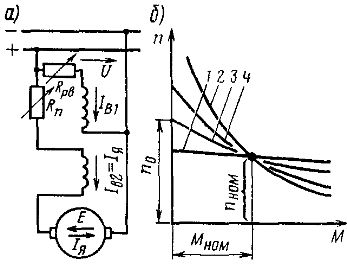
Rice. 5. Schematic diagram of an electric motor with mixed excitation (a) and its mechanical characteristics (b)
The advantage of the DC motor with mixed excitation is that it, having a soft mechanical characteristic, can operate at idle when Fposl = 0. In this mode, the frequency of rotation of its armature is determined by the magnetic flux Fpar and has a limited value ( engine not running).
